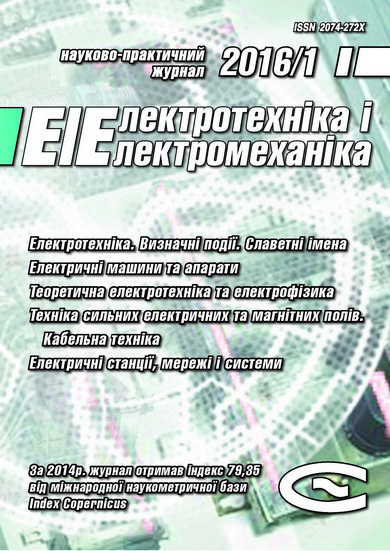RESEARCH OF THE APPLICATIONS POSSIBILITY OF INTERFACE RELAY IN HYBRID SWITCHING SYSTEMS OF BISTABLE ACTUATORS WINDINGS
DOI:
https://doi.org/10.20998/2074-272X.2016.1.04Keywords:
bistable actuators, interface relays, contact bounce, hybrid switchingAbstract
Purpose. Development of methods of experimental determination of action coordination characteristics of semiconductor and mechanical switching elements in systems of hybrid commutation of bistable actuators coils taking into account contact bounce of mechanical switching elements. Consideration of the application possibility of interface relay as mechanical switches, and the definition of the duration of the intervals to ensure coordination of the relay operation with semiconductor switches. Methodology. Experimental determination of the time intervals between the moments of switching transistor which controls the relay coil, and power transistor when the switching on and off operations using a hybrid switching device are performed; statistical processing of experimental results. Results. The durations of the time intervals between the moments of switching of semiconductor and mechanical switching elements in systems of actuator coils hybrid commutation are experimentally determined. A way of a significant reduction of the duration of the indicated time intervals is considered and experimentally confirmed. Originality. The scheme of the power circuit of the control system with hybrid commutation of the actuator coil circuit, which differs from the known schemes that the only semiconductor switching element performs functions of the current switching on and off, and electromechanical relay contact elements act as a router interconnecting electrical circuits during dead times. Practical value. The use of hybrid switches instead of switches with semiconductor switches will significantly reduce the cost of the actuators control system, as well as reduce their sizes.References
Dullni E., Fink H., Reuber C. A vacuum circuit-breaker with permanent magnetic actuator and electronic control. Available at: https://library.e.abb.com/public/5e750b2ecc5b760ec1256ad4002d2c00/cired99_Nice_VM1.pdf (accessed 15 October 2015).
Klymenko B.V., Vyrovets S.V., Forkun Ya.B. Elektromagnitnyi privod [Electromagnetic actuator]. Patent Russian Federation, no. 2312420, 2007. (Rus).
Soskov A.G., Sabalaeva N.O. Hibrydni kontaktory nyzkoi napruhy z pokrashchenymy tekhniko-ekonomichnymy kharakterystykamy: monohrafiia [Hybrid contactors low voltage with improved technical and economic characteristics]. Kharkiv, National University of Urban Economy Publ., 2012. 268 p. (Ukr).
Meyer J.-M., Rufer A. A DC hybrid circuit breaker with ultra-fast contact opening and integrated gate-commutated thyristors (IGCTs) // IEEE Transactions on Power Delivery. – 2006. – vol.21. – no.2. – pp. 646-651. doi: 10.1109/tpwrd.2006.870981.
Häfner J., Jacobson B. Proactive hybrid HVDC breakers – a key innovation for reliable HVDC grids // Integrating supergrids and microgrids International Symposium in Bologna, Italy. – 2011.
Kapoor R., Shukla A., Demetriades G. State of art of power electronics in circuit breaker technology // 2012 IEEE Energy Conversion Congress and Exposition (ECCE). – 2012. – pp. 615-622. doi: 10.1109/ECCE.2012.6342764.
Downloads
Published
How to Cite
Issue
Section
License
Copyright (c) 2016 B. V. Klymenko, A. V. Eres'ko, I. S. Varshamova, N. A. Lelyuk

This work is licensed under a Creative Commons Attribution-NonCommercial 4.0 International License.
Authors who publish with this journal agree to the following terms:
1. Authors retain copyright and grant the journal right of first publication with the work simultaneously licensed under a Creative Commons Attribution License that allows others to share the work with an acknowledgement of the work's authorship and initial publication in this journal.
2. Authors are able to enter into separate, additional contractual arrangements for the non-exclusive distribution of the journal's published version of the work (e.g., post it to an institutional repository or publish it in a book), with an acknowledgement of its initial publication in this journal.
3. Authors are permitted and encouraged to post their work online (e.g., in institutional repositories or on their website) prior to and during the submission process, as it can lead to productive exchanges, as well as earlier and greater citation of published work.





